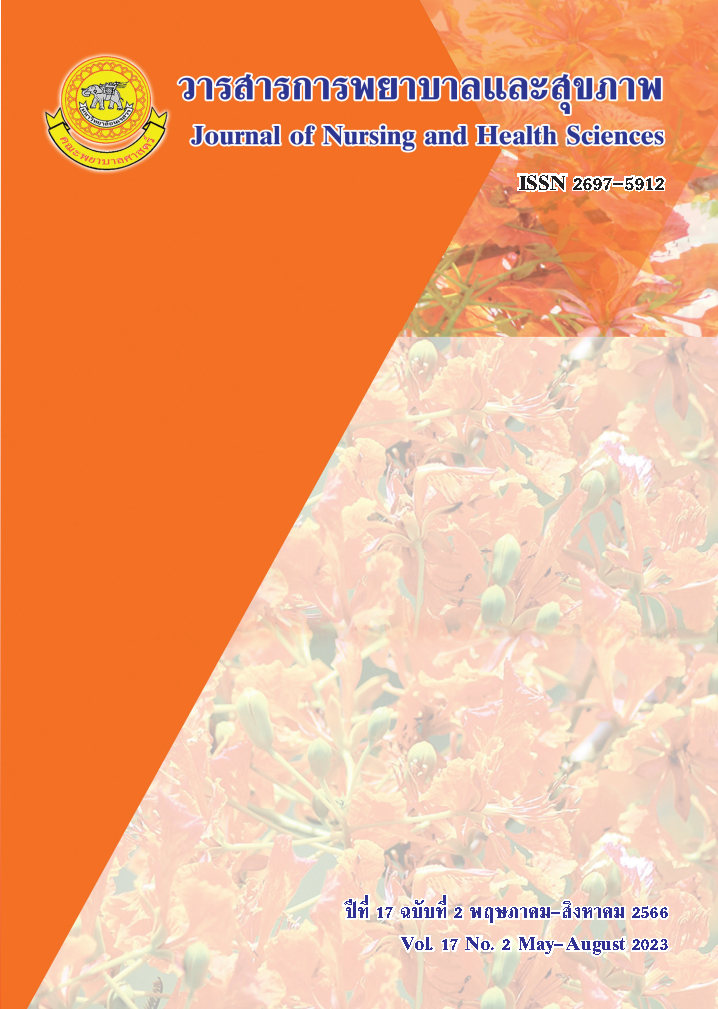ความสัมพันธ์ระหว่างความรู้ทัศนคติและการปฏิบัติต่อการบริโภคเกลือในกลุ่มพยาบาลไทย
Main Article Content
บทคัดย่อ
งานวิจัยจำนวนมากศึกษาความสัมพันธ์ระหว่างความรู้ ทัศนคติและการยอมรับปฏิบัติต่อการบริโภคเกลือ อย่างไรก็ตาม งานวิจัยที่ศึกษาความสัมพันธ์ของปัจจัยทั้งสามนี้ในกลุ่มพยาบาลยังมีจำนวนไม่มาก วัตถุประสงค์ของงานวิจัยนี้คือเพื่อศึกษาระดับความรู้ ทัศนคติและการยอมรับปฏิบัติต่อการบริโภคเกลือในกลุ่มพยาบาลไทยที่ปฏิบัติงานที่โรงพยาบาลมหาวิทยาลัยนเรศวรและหาความสัมพันธ์ของปัจจัยทั้งสามนี้ อาสาสมัครที่เข้าร่วมในงานวิจัยนี้คือ พยาบาล จำนวน 135 คน โดยมีการเก็บข้อมูลจากแบบสอบถามออนไลน์ อาสาสมัครส่วนใหญ่เป็นเพศหญิง เครื่องมือวิจัยเป็นแบบสอบถามแบบมีโครงสร้างเพื่อใช้ประเมินระดับความรู้ ทัศนคติและการยอมรับปฏิบัติต่อการบริโภคเกลือ ผลการวิจัยพบว่า อาสาสมัครส่วนใหญ่มีค่าดัชนีมวลกายอยู่ในระดับปกติและมีความรู้ ทัศนคติและการยอมรับปฏิบัติต่อการบริโภคเกลืออยู่ในระดับกลาง อาสาสมัครทั้งหมดเห็นด้วยว่าการบริโภคเกลือปริมาณมากสัมพันธ์กับโรคไตและความดันโลหิตสูง อาสาสมัครส่วนใหญ่ยอมรับว่าบริโภคเกลือเกินปริมาณที่บุคลากรทางการแพทย์แนะนำ นอกจากนี้ ผลการวิจัยจากค่าสัมประสิทธิ์สหสัมพันธ์แบบเพียรสันพบว่า ความรู้ในการบริโภคเกลือมีความสัมพันธ์ทางบวกกับทัศนคติในการบริโภคเกลือ อย่างไรก็ตาม ไม่พบความสัมพันธ์ระหว่างความรู้และการยอมรับปฏิบัติต่อการบริโภคเกลือ หรือความสัมพันธ์ระหว่างทัศนคติและการยอมรับปฏิบัติต่อการบริโภคเกลือ ข้อค้นพบเหล่านี้แสดงให้เห็นถึงความจำเป็นในการออกแบบสื่อการสอนและการให้คำแนะนำเรื่องการบริโภคเกลือเพื่อเพิ่มระดับความรู้ ทัศนคติและการยอมรับปฏิบัติต่อการบริโภคเกลือในกลุ่มพยาบาลไทย
Article Details

อนุญาตภายใต้เงื่อนไข Creative Commons Attribution-NonCommercial-NoDerivatives 4.0 International License.
เอกสารอ้างอิง
Bhattacharya, S., Thakur, J., & Singh, A. (2018). Knowledge attitude, and practice regarding dietary salt
intake among urban slum population of North India.
Journal of Family Medicine and Primary Care, 7(3),
-530. https://doi.org/10.4103/jfmpc.jfmpc_60_17.
Chailimpamontree, W., Kantachuvesiri, S., Aekplakorn,
W., Lappichetpaiboon, R., Sripaiboonkij Thokanit,
N., Vathesatogkit, P., . . . Chuaykarn, N. (2021).
Estimated dietary sodium intake in Thailand:
A nationwide population survey with 24-hour urine
collections. The Journal of Clinical Hypertension,
(4), 744-754. https://doi.org/10.1111/jch.14147.
Cheikh Ismail, L., Hashim, M., H. Jarrar, A., N. Mohamad,
M., T. Saleh, S., Jawish, N., . . . Aldarweesh, D.
(2019). Knowledge, attitude, and practice on salt and
assessment of dietary salt and fat intake among
University of Sharjah students. Nutrients, 11(5), 941.
https://doi.org/10.3390/nu11050941.
Department of Medical Services. (2020). Sodium, danger
from tasty food: Recommendations to reduce salt
intake. News for Mass Media. Retrieved January 2,
, from https://drive.google.com/file/d/1FwW88o
lHDMQw2-XEFah3P4zwlrpTYbkp/view?fbclid=
IwAR24Ziegtru9KvO-Myu9pYcEBIVzWB0kr
HkuIYFfYmBKihWzVgLKn4bw1FE&pli=1 [โซเดียม
ภัยเงียบจำกของอร่อย แนะนำวิธีลดเค็มง่ำย ๆ ห่ำง
ไกลโรคไต]. [In Thai].
Ghimire, K., Adhikari, T. B., Rijal, A., Kallestrup, P.,
Henry, M. E., & Neupane, D. (2019). Knowledge,
attitudes, and practices related to salt consumption
in Nepal: Findings from the community-based
management of non-communicable diseases project
in Nepal (COBIN). The Journal of Clinical
Hypertension, 21(6), 739-748. doi: 10.1111/jch.13544.
Haron, H., Kamal, N. F., Yahya, H. M., & Shahar, S.
(2021). Knowledge, attitude and practice (KAP) of
Malay elderly on salt intake and its relationship with
blood pressure. Front Public Health. 2021 Feb
;8:559071. doi: 10.3389/fpubh.2020.559071. PMID:
; PMCID: PMC7890185.
He, F. J., & MacGregor, G. A. (2010). Reducing
population salt intake worldwide: from evidence to
implementation. Progress in cardiovascular diseases,
(5), 363-382. https://doi.org/10.1016/j.pcad.2009.12.006
He, F. J., & Macgregor, G. A. (2012). Salt intake, plasma
sodium, and worldwide salt reduction. Annals of
medicine, 44(sup1), S127-S137. https://doi.org/10.
/07853890.2012.660495
Kasemsup, R., & Taneepanichskul, S. (2013). Sodium
intake and socio-demographic determinants of the
non-compliance with daily sodium intake recommendations: Thai NHES IV. J Med Assoc Thai, 96(5),
S161-S170. [In Thai].
Khokhar, D., Nowson, C., Margerison, C., Bolam, B., &
Grimes, C. (2019). Comparison of salt-related
knowledge, attitudes and behaviours between parents
and caregivers of children under 18 years of age and
other adults who do not care for children under 18
years of age in Victoria, Australia. BMJ nutrition,
prevention & health, 2(2), 51-62.
Launiala, A. (2009). How much can a KAP survey tell
us about people’s knowledge, attitudes and practices?
Some observations from medical anthropology
research on malaria in pregnancy in Malawi.
Anthropology Matters, 11(1). 1-13.
Leyvraz, M., Mizéhoun-Adissoda, C., Houinato, D.,
Moussa Baldé, N., Damasceno, A., Viswanathan,
B., . . . Bovet, P. (2018). Food consumption,
knowledge, attitudes, and practices related to salt in
urban areas in five sub-saharan African countries.
Nutrients, 10(8), 1028. https://doi.org/10.3390/
nu10081028.
Mahat, D., Isa, Z. M., Tamil, A. M., Mahmood, M. I.,
Othman, F., & Ambak, R. (2017). The association
of knowledge, attitude and practice with 24 hours
urinary sodium excretion among Malay healthcare
staff in Malaysia. International Journal of Public
Health Research, 7(2), 860-870.
Makowski, D., Ben-Shachar, M. S., Patil, I., & Lüdecke,
D. (2020). Methods and algorithms for correlation
analysis in R. Journal of Open Source Software,
(51), 2306. https://doi.org/10.21105/joss.02306.
Mondal, R., Sarker, R. C., Sayrin, R., Afrin, R., Zaman,
K., Acharya, N. P., . . . Choudhury, S. R. (2019).
Knowledge, Attitude and Practice towards Dietary
Salt Intake among Nurses Working in a Cardiac
Hospital in Bangladesh Sciences. Cardiovascular
Journal, 12(1), 53-58. https://doi.org/10.3329/cardio.
v12i1.43420.
Photi, J., Chavasit, V., Chitchang, U., Egkantrong, P.,
Chinchanupap, K., & Boonpraderm, A. (2020).
Reduction of sodium intake from papaya salad with
the use of sodium-reduced fermented fish in
producing traditional seasoning sauce. Journal of
nutritional science and vitaminology, 66(Supplement),
S173-S178. https://doi.org/10.3177/jnsv.66.S173.
R Core Team. (2022). R: A language and environment
for statistical computing. Vienna, Austria: R
Foundation for Statistical Computing. Available
online at https://www.R-project.org/.
Rusmevichientong, P., Morales, C., Castorena, G.,
Sapbamrer, R., Seesen, M., & Siviroj, P. (2021).
Dietary salt-related determinants of hypertension in
rural northern Thailand. International Journal of
Environmental Research and Public Health, 18(2),
Schneider, B. (2003). Measuring results: Gaining insight
on behavior change strategies and evaluation
methods from environmental education, museum,
health, and social marketing programs. New York:
Coevolution Institute.
World Health Organization. (2012). Guideline: Sodium
intake for adults and children. Switzerland: World
Health Organization.
World Health Organization BMI classification. (2016).
Secondary BMI classification. Retrieved from http://
apps.who.int/bmi/index.jsp?introPage=intro_3.html
Xu, W., Sun, G., Lin, Z., Chen, M., Yang, B., Chen, H.,
… Cao, K. (2010). Knowledge, attitude, and
behavior in patients with atrial fibrillation
undergoing radiofrequency catheter ablation.
Journal of interventional cardiac electrophysiology,
(3), 199-207. https://doi.org/10.1007/s10840-010-
-2.
Yamane, T. (1973). Statistics: an introductory analysis
(3rd ed.). New York: Harper and Row.
Zhang, J., Xu, A.-q., Ma, J.-x., Shi, X.-m., Guo, X.-l.,
Engelgau, M., . . . Wang, H.-c. (2013). Dietary
sodium intake: knowledge, attitudes and practices
in Shandong Province, China, 2011. PloS one, 8(3),
e58973.


